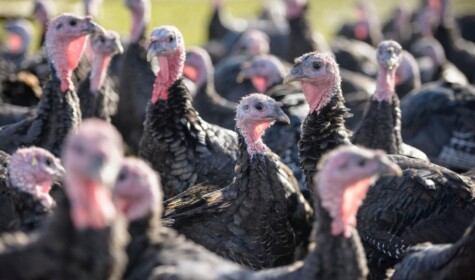As we get ready for Christmas the question most of us are asking is, what are we going to eat for Christmas dinner? Many of us have established family traditions and eat the same thing every year. Some have duck or goose, others prefer ham or lamb, but most of us eat turkey. It’s a great choice if you’re feeding lots of people, and there are usually leftovers for a delicious turkey sandwich with cranberry sauce on Boxing Day.
Every year some 16 million turkeys are slaughtered in the United Kingdom, 10 million of which are eaten at Christmas. For all but a small number of organic and free-range turkeys, their short lives are pretty miserable – confined to a shockingly small space with little or no access to the outdoors, often kept in the dark for the entirety of their lives, trucked sometimes hundreds of miles in crates, and summarily killed for our celebratory consumption. There is no getting around the hard facts behind our festivities. So spare a thought for your bird: buy well and make sure you get the giblets.
To help you do this, we’ve tried to map out what you get for your money in terms of animal welfare, tasty breeds and what might or might not be done to your bird in the processing. Turkeys are very definitely not much of a muchness. They vary a lot in flavour, texture and juiciness and the difference can definitely be tasted. They also vary a lot in terms of what you might be getting in your meat with regards to chemicals, water, flavouring, GMOs, residual antibiotics and growth promoters.
What animal welfare standards are you buying into?
Certified organic British turkey
Organic turkey is definitely the way to go if you can afford it. Vote for a better life for your bird and it should deliver on taste as well. To carry the word ‘organic’ on its label, it must be certified and adhere to the best animal welfare standards. Organic turkeys will likely be slow maturing (so they will live about twice as long as conventional birds) and spend their days doing what is natural to them – scratching around fields in the open air. They will have more space than either free-range or conventional birds when they are bedded up for the night. They won’t be on GM feed or given growth promoters, and antibiotics will only be given only if a bird is actually ill.
Also, make sure your organic turkey is British, especially if you are buying it from a supermarket – there is no sense in buying from abroad when there are so many good organic producers here in the United Kingdom. Many are small-scale and artisanal, which means your turkey is often getting special attention. It will likely be ‘hung’ (more on that below); it may be dry plucked by hand with careful attention to the finish on the skin; and it may be fed a special mix of grains. Eversfield Organic, a 450-acre mixed organic farm in Devon, ensures their birds forage and eat acorns as well as a grain mix that is grown on the same farm.
‘Free-range’
Most of us think that ‘free-range’ is a good alternative to buying fully organic birds, but beware! Free-range is a wide designation and minimum standards are pretty low. Free-range only means that the birds have ‘access to the outdoors’ – something that is not as straightforward as it sounds. Many free-range turkeys may never go outside – as naturally nervous, timid creatures, negotiating their way past other dominant turkeys through a single door often proves too much for many. And what’s on the other side is rarely green pasture. There are no restrictions on free-range birds being given GM feed or preventative antibiotics and the birds’ beaks can be ‘trimmed’, which effectively means cut-off. Free-range can be almost as industrial as conventional production.
However, not all free-range production is at the industrial end. There are many smaller-scale producers of free-range birds that do offer meaningfully higher welfare standards. Walter’s Turkeys, for example, which supply Riverford with their organic turkeys, also raises free-range birds that spend their days outside, are not fed on GM feed, and are only given antibiotics when sick. They also carry a ‘traditional speciality guarantee’ designation, which means they are hung, dry plucked and have the giblets included.
If you are buying a free-range bird, you should talk to your farmer or butcher and know exactly what you are getting. Find out about the scale of the operation, how the birds live, what they eat and how the turkeys are processed.
Conventional
Buying a conventional turkey from the supermarket is certainly the cheapest option, but we’d really recommend you don’t! The life of a battery turkey is much like the life of battery chicken and minimum standards are very basic, making for a short, stressful life in a very small space. Conventional turkeys are bred to produce a huge amount of breast meat, which makes them top heavy. As they come to slaughter they can often hardly move and develop leg problems (they cannot breed naturally either). They also have their beaks clipped to prevent pecking and they are never allowed to see the light of day or, indeed, any light at all – they are often kept in darkened sheds to prevent spooking which can be a problem. Animal welfare aside, conventional turkeys are heavily treated with antibiotics (it’s in their drinking water) and may be infused with flavour enhancers and water. Yum.
A couple of other things to think about
Breeds
There is more variety these days in the breeds available. The traditional white turkey that dominates conventional production has been bred for size rather than taste – like a supermarket tomato. Since breast meat is the most popular (witness the market for turkey ‘crowns’), these birds have become so top heavy they cannot fly or breed naturally. In the last decade, however, heritage breeds, such as Norfolk Blacks and Bronzes, have become more popular. Norfolk Blacks are slow maturing and therefore have a more developed flavour and meatier texture.
You may also come across the term ‘wild turkeys’. This term is not regulated and it is not a breed, as some people think. It implies that the birds are fully free-range, allowed to roam where they want. But if you come across the term, don’t take it at face value – find out what the producer means if you can.
Dry pluck versus wet pluck
Most poultry is wet plucked, even in organic systems. It means that after slaughter the bird goes into a bath of simmering water to make the feathers easier to remove. However, the presence of water can spread campylobacter and other bacteria, so it is arguably less hygienic. A dry pluck is where no water is involved and the feathers are waxed off. Some producers feel this improves the quality of the skin.
Hanging
Most higher end producers hang turkeys whole with the innards intact for around 10 days. As with other meat, this enhances the flavour, texture and moisture. This can make a big difference to taste.
Where are the giblets?
Search the web for giblets and the question comes up again and again: where are they? When we asked one turkey producer, he said that rigorous food safety standards means even more paperwork for the giblets. But offal generally, as Tessa Tricks points out, has become a waste product for most of us and we don’t know what to do with it. But our advice is make sure you get those giblets. Good gravy is what turkey is all about, and without the giblets there’s no gravy.
Whichever bird you choose for your Christmas table, it is worth remembering that the Christmas meal signifies the coming together of our communities to celebrate and share food between us. Historically the biggest, most delicious and prized birds, were carefully nurtured, fattened up slowly to make them prized for the Christmas feast. In a season when we are encouraged to think more about giving, generosity and caring, it is worth asking ourselves whether or not the bird on our table reflects these values. Try and choose a bird that has lived the best possible life for the budget you have available, and indulge in your Christmas dinner without the nasty after-taste of animal suffering on your conscience.
First published 12 December 2014






